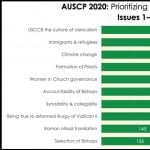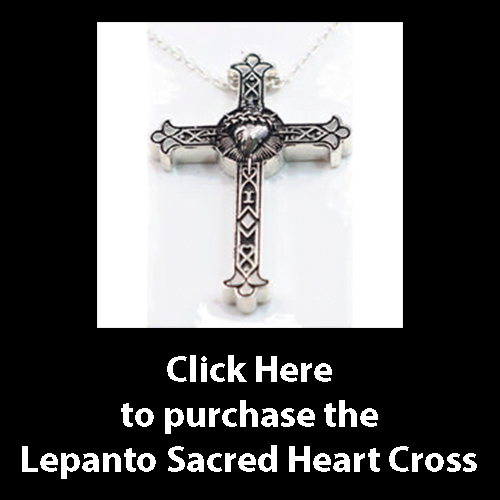 Three-thousand, four-hundred years ago, three men charged Moses and Aaron with “clericalism,” and led a rebellion against them. The Book of Numbers chapter 16 says that Korah, Dathan and Abiram:
Three-thousand, four-hundred years ago, three men charged Moses and Aaron with “clericalism,” and led a rebellion against them. The Book of Numbers chapter 16 says that Korah, Dathan and Abiram:
took two hundred and fifty Israelites who were leaders in the community, members of the council and men of note, and confronted Moses. Holding an assembly against Moses and Aaron, they said, “You go too far! The whole community, all of them, are holy; the LORD is in their midst. Why then should you set yourselves over the LORD’s assembly?”
One month ago, an assembly of the heresy-minded Association of United States Catholic Priests (AUSCP) initiated an identical rebellion against Holy Mother Church. Echoing the sentiments of Korah, Dathan and Abiram that Moses and Aaron “set [themselves] over the Lord’s assembly,” the AUSCP levels a charge of “clericalism” against the Catholic Church’s hierarchical structure. Repeating the three rebels in the claim that “the whole community, all of them, are holy; the Lord is in their midst,” the AUSCP posits that “clericalism” imposes a sort of caste system, driving a wedge between priests and laymen.
For the past few weeks, the Lepanto Institute has produced several reports on the actions and positions taken by the AUSCP, and links to some of these reports are as follows:
- AUSCP Officially Called for Women’s Ordination to the Priesthood
- AUSCP Gives Venue to Condemned LGBT Organizations
- AUSCP’s Plan for Ordained Women and Priestless parishes
- AUSCP’s Idea for Priestly Formation and Info on Conference speakers
- AUSCP’s Desire to Obtain Funding from Unsuspecting, Pew-sitting Catholics
- AUSCP’s Membership in an International Network of Heretical Organizations
- AUSCP’s Alliance with Heretical, Pro-Sodomy Organizations
- AUSCP’s Keynote Address from Notorious Priest, Fr. Richard Rohr
- AUSCP’s Vision of the Church in Relation to the Vision of Bl. Anne Catherine Emmerich
Before we examine AUSCP’s newest initiative, it is imperative to keep the following dogmatic teachings of the Church in mind.
- The Church was founded by Jesus Christ. As Pope St. Pius X stated in the Anti-modernist Oath, “The Church was founded immediately and personally by the true and historical Christ during the time of His earthly life.”
- Christ gave His Church a hierarchical constitution. The Council of Trent declared, “If any one saith, that, in the Catholic Church there is not a hierarchy by divine ordination instituted, consisting of bishops, priests, and ministers; let him be anathema.” Pius X condemned the following statement (54) in Lamentabili Sane: “Dogmas, Sacraments and hierarchy, both their notion and reality, are only interpretations and evolutions of the Christian intelligence which have increased and perfected the little germ latent in the Gospel by an external series of additions.”
- Holy Orders is a true and proper Sacrament which was instituted by Christ. From the Council of Trent, “If any one saith, that order, or sacred ordination, is not truly and properly a sacrament instituted by Christ the Lord; or, that it is a kind of human figment devised by men unskilled in ecclesiastical matters; or, that it is only a kind of rite for choosing ministers of the word of God and of the sacraments; let him be anathema.”
- The Sacrament of Orders imprints a character on the recipient. This character is distinct from and transcends the character imprinted by baptism and confirmation. From the Council of Trent: “If any one saith, that, by sacred ordination, the Holy Ghost is not given; and that vainly therefore do the bishops say, Receive ye the Holy Ghost; or, that a character is not imprinted by that ordination; or, that he who has once been a priest, can again become a layman; let him be anathema.”
- The Sacrament of Orders confers a permanent spiritual power on the recipient. From the Council of Trent, “If any one saith, that there is not in the New Testament a visible and external priesthood; or that there is not any power of consecrating and offering the true body and blood of the Lord, and of forgiving and retaining sins; but only an office and bare ministry of preaching the Gospel, or, that those who do not preach are not priests at all; let him be anathema.”
These are dogmatic teachings of the Church. To deny or cast doubt on these teachings is objectively heretical.
However, the AUSCP, in collaboration with Voice of the Faithful (VOTF) and FutureChurch is directly undermining all the above teachings in a revolutionary initiative called BridgeDialogues: laity and clergy reimagining the church. The resource pack for these BridgeDialogues is not available to the general public, but a supporter provided a copy to the Lepanto Institute which we have in our possession. The BridgeDialogues purports to be a set of open-ended discussions about clericalism, which it identifies as the source for many of the ills currently facing the Church. In reality, the BridgeDialogues leads participants through a highly selective set of readings and discussion questions to reach an intended destination. 
The primary strategy used in these dialogues is to introduce a real and current crisis, seed in some false problems or straw-men causes for these problems and lead the participant to revolutionary solutions. This is the same method used by communist revolutionaries. The communists rightly identified the evils of unbridled Capitalism while wrongly identifying legitimate practices of free market economics all while steering followers to the revolutionary and evil doctrines of communism.
BridgeDialogues First Module
The first module (or “model” as termed in the resource pack) immediately assumes that the “culture of the Roman Catholic diocesan clergy” is “clearly” the cause of the priestly sex abuse crisis, the cover-up by the bishops as well as a host of other damaging consequences to both the laity and priests. According to the Dialogues, this priestly culture (“clericalism”) is different from other professional cultures because it has these characteristics:
- The hierarchical and patriarchal structure of the church
- Papal allegiance
- An ordination which is said to confer an ontological change
- Special education and training
- Celibacy requirements
- Clothing and dress—especially liturgical dress
- Special privileges concerning compensation and lifestyle
As you can see, the module is already including dogmatic teachings of the Church under the charge of clericalism. The module then goes on to subtly (and sometimes not so subtly) undermine Catholic teaching and discipline on many of these points.
For example, this BridgeDialogue module:
- Sets up a negative comparison between nations with a balance of power and the hierarchy of the Church, asserting that “Despite the Second Vatican Council’s emphasis on the collegiality of the bishops, under Pope John Paul II and Pope Benedict XVI a re-emphasis on Rome’s authority took place.”
- Decries the “patriarchy” of the Church, claiming “Only men are allowed into the priesthood and, thus, all bishops and cardinals are male. This excludes female input into the decision-making of the Church and effectively cuts the leadership of the Church off from the gifts of the wisdom of women at every level of Church governance.”
- After stating that the “notion” that ordination confers an ontological change is primarily of modern origin, it goes on to imply that there is legitimate disagreement with this DOGMATIC TEACHING because “contemporary theologians…have suggested that this concept of an ‘ontological change’ should be challenged in favor of a more functional understanding.”

BridgeDialogues Second Module
The second module’s reading is nothing but professor Massimo Faggiolli’s presentation at the 2018 VOTF Conference. This presentation purports to be about the theology of the laity, but almost immediately devolves into a screed against Pope St. Pius X’s fight against the modernist heresy. Faggiolli then launches into outright and blatant heretical teaching about the development of the hierarchical structure of the Church. Remember, this is being presented by the AUSCP as solid reading material for unsuspecting parishioners!
Examples:
- Faggioli calls the fight against the heresy of Modernism, “the anti-modernist crisis, which is the most serious intellectual catastrophe in the Catholic Church…” (p. 3)
- Faggioli blatently directly contradict Church teaching that Christ gave his Church a hierarchical constitution from the beginning, and closely mirrors the condemned proposition outlined in Lamentabili Sane. (p. 3) with these two statements, “The third, especially the 3rd and early 4th centuries, is the beginning of a hierarchical organization in the Catholic Church.” and “The third phase is the so-called Imperial Church, when the Church becomes much more hierarchical, in some sense because it mirrors the empire. When you relate to the empire, you become more imperial, right?”
- Faggioli states that women should be ordained as deaconesses. (p. 9) And while he doesn’t outright call for the ordination of women as priests, he simply states that a female priesthood would “automatically alienate large portions of the Catholic Church” at this time.

BridgeDialogues Third Module
The third module is mainly a selection of quotes from Pope Francis discussing clericalism. Pope Francis does not define clericalism in these quotes, and it is disingenuous for this module to assume that Pope Francis’ definition of clericalism is the same as presented in these BridgeDialogues.
BridgeDialogues Fourth Module
The fourth BridgeDialogue module consists of the AUSCP’s recent white paper on clericalism and a section of discussion questions. Anecdotes of people’s experiences with “clericalism” from priests and bishops are peppered throughout the text. Some of these anecdotes represent very real abuses of power or true clericalism. However, a good number of these stories representing “clericalism” are simply traditional and orthodox behavior. The white paper states:
“The undercutting of pastoral service may yield another debilitating form of clericalism, one that directs itself against other priests. Adherence to protocols and rigid conformity has produced priests who consider it their duty to “correct” any priest they deem to be less than rigorous in upholding the rituals than he himself was taught.” (p. 20)
These three stories, for instance, are presented to the readers as clericalist abuses:
“At his first Sunday Mass a new pastor told the congregation that he expected to be there for 30 years and there would be some immediate changes. If it’s not in the Missal it’s not being done—no deviations or even slight changes.” (p. 26)
“A man came forward to receive Holy Communion. The priest placed the host in the communicant’s open hand. After noticing who it was and remembering that he was in a marriage “outside the church,” the priest snatched back the host from the communicant’s hand. Some parishioners left the parish because of the priest’s behavior.” (p. 26)
“The Archbishop of a large metropolitan diocese observed that some of the newly ordained were saying their first Mass in Latin rather than in English. He became even more alarmed when he saw a glossy photo of a soon-to-be ordained seminarian, who had put on a cassock, cape, cane, and biretta for the photo. The bishop called the seminarian and told him not to dress that way again and to stop distributing such photos. The Archbishop now worries about what underlies the seminarian’s behavior.” (p. 21)
The white paper even accuses lay people of clericalism for following tradition:
“Unfortunately, clericalism also infects some of the solutions proposed to mitigate the Church’s problems today. Some clerics—and lay people too—believe that following rules, policing rituals, and clearing out those who do not share the same vision of Church as theirs will somehow restore its ‘holiness.’” (p. 25)
Beyond this, and far worse, is that the white paper teaches that Jesus only started a movement of servant missionary disciples, not to be called rabbi or father, and empowered them to heal “at times.” (p. 23) It was only later that a hierarchy came into existence as well as the sacramental notion of the priesthood:
Unfortunately, in the centuries following the Letter to the Hebrews, the tradition of Jewish Temple priesthood and that of Rome’s pagan temple priesthoods co-opted the Scriptural understanding of the Risen Jesus as a priest according to the order of Melchizedek. Over a three-century span of time, the elders of the missionary disciples that Jesus sent forth came to be seen as a special caste of priests and overseers.
Their special status was enhanced when the Emperor Constantine legalized Christianity. Then, when a later emperor declared Christianity to be the official religion of the Empire, the status of bishops and priests grew even more exalted. They became “clerics”—recognized dignitaries with civic and imperial authority.
The choices made to adopt imperial trappings may have served the early Church’s needs. It no doubt helped continue the spread of Christianity. But over time this clerical status, initiated for civic and imperial purposes, had a predictable human result. Many of the clerics started behaving like persons “lording it over” those who were not clerics in both church and society. Ultimately, the specialness of priests and bishops became not only part of civil law but also, in 12th century Church teaching, was ratified by the sacrament of Holy Orders. By the year 1200, the Christian Church consisted of two distinct groups: the clergy, and those who were not—the “laity.” Clerics secured control over the community, the assembly of God’s people.” (p. 24)
This again flies in the face of the Church teaching that Christ gave his Church a hierarchical constitution from the beginning, and closely mirrors the condemned proposition outlined in Lamentabili Sane above.
BridgeDialogues “Responsibilities and Rights of Laity”
Finally, in the BridgeDialogues’ final section, we get our clearest heretical statement, as if the authors know the reader is now prepared to accept it after the more subtle influences in the previous modules.
“In its earliest days, the Church had no clergy, no laity, simply a community of believers.” And thus, the program of AUSCP, VOTF and FutureChurch is laid bare. With the constant drum beat that we need to return to the ways of the early church we can see that they are seeking an outright revolution against the hierarchy and sacrament of Holy Orders as instituted by Christ! 
The fifth section goes on:
Gradually, however, our increasingly structured Church focused in official documents, century after century, on the development and rights of hierarchical offices. The laity, when they were described at all, mostly were described as recipients of whatever actions their pastors and bishops took. This imbalance continued until the Second Vatican Council renewed the focus on the entire People of God.
Bear in mind that this is not a mere flash-in-the pan endeavor. The BridgeDialogues are being brought to parishes by AUSCP priests and their lay supporters. In fact, laymen are being encouraged to:
- Organize more BridgeDialogues
- Join your parish council
- Express the concerns of the AUSCP to your bishops and urge the reform of seminary education following the AUSCP model
- Promote the discussion of women deacons
Everything about these supposed dialogue sessions on clericalism are nothing short of the beginnings of open rebellion within the Church. AUSCP and its allies are attempting to overthrow the Church’s entire structure, remaking the Church in their own image and likeness. But just as Korah, Dathan and Abiram were swallowed whole into the bowels of Hell, these disaffected heretics will no doubt meet a similar fate if they do not reverse course, now.
This joint program by the AUSCP, VOTF and FutureChurch is a very real and present danger to the Church and may very well be coming soon to a parish near you. We urge you to first be vigilant and on guard for this program and secondly be pro-active and share this information with your parish and your diocese in the hope that they will not allow these false dialogues to take place in your area.







Thanks for sharing this information!! Is there a list of AUSCP membership to know which bishops & priests are supporting this organization?
I would also be interested in a list of AUSCP members. Would there be an available list of those in attendance in St. Louis this month?
Heretics with better ideas have abounded since Simon Magnus tried to buy an apostleship. Even Bishop of Rome, St. Clement I, successor of St. Peter’s chair, railed in his letter to the “laity” of Corinth, that they should give “all fitting honour to the presbyters among you.” This was written between 88 and 99 A.D. Paul laid hands on Titus and Timothy telling them to do the same. Who do you suppose was consecrating the bread and wine? It wasn’t your basic “lay” person. I don’t know what they call a hierarchy, but Acts of the Apostles and Paul’s letters sure sound hierarchical to me. These ideologue priests sound like poorly formed spawn of Bernardine and McCarrick who want to shape the church into their image. Bah humbug. Why don’t they just call themselves what they are, protestants who want to hijack the Body and Blood of our Blessed Lord. List them publicly please.